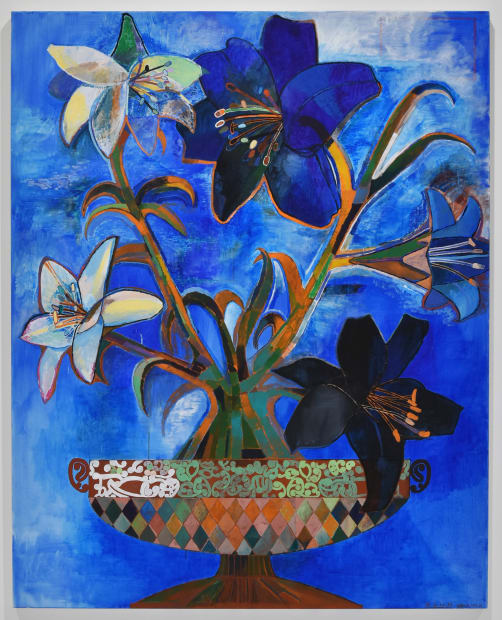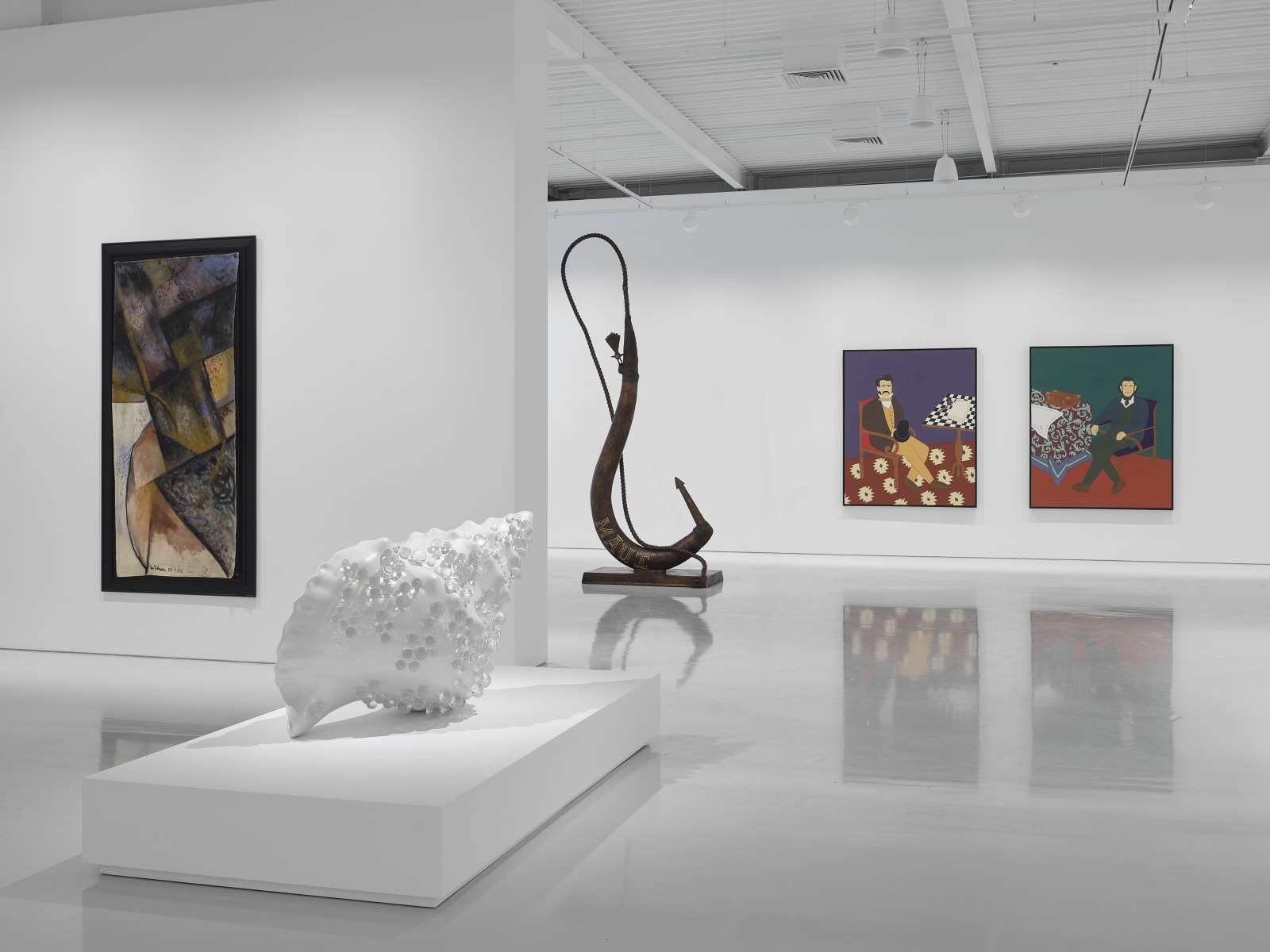-

This Must Be the Place is the inaugural exhibition at Gow Langsford’s flagship Onehunga premises. It brings together the work of a diverse range of artists who respond to themes of place, belonging, and cultural legacy. In examining locality in Aotearoa and Oceania through a modern and contemporary lens, This Must Be the Place showcases practices and contextual frameworks from the region. Writer and academic Damon Selesa commented on the unique nature of this setting, stating, “The largest single feature in the world, fully one-third of its surface, is the Pacific Ocean. So vast that all the land in the world would fit inside its perimeter, the Pacific is virtually incomparable.”[1]
Historically, Oceania has not held a presence in cultural discourse proportional to its immense scale; widely circulated cultural histories have tended to be Euro- and Amero-centric. Salesa states, “[…] the history of Oceania seems, to those who know it, as rich in significance, complexity, achievement and human experience as any region on Earth. Yet outside of its bounds, and on the continents particularly, it is little known, marginalised, disavowed or excised. In world histories, as even in world maps, the biggest thing on Earth actually manages to be omitted or divided or occluded.”[2] In ways both subtle and overt, this has affected cultural and political discourses in Aotearoa and Oceania.
On the visual culture of this environment, writer Keith Stewart stated, “Western Oceania is at the very end of human lineage, the last place on earth to be colonised by homo sapiens, a fact that creates a deep root system of visual language that is the accumulation of journeys into the last corner of the Pacific from virtually every cultural homeland on earth.”[3] As Stewart observes, specificity of location and nature of place have been a factor in shaping contemporary visual culture in this part of the world. Here, in stories told through contemporary visual language, This Must Be the Place presents a nuanced discourse on location, life, migratory journeys, and local history.
Hardwired into this is the migratory nature of peoples in this part of the world. In their publication for the Royal Academy of Arts exhibition Oceania, curators Peter Brunt and Nicholas Thomas wrote, “Twentieth-century migration entailed inherent dislocation, from cultural milieux as well as from place. Sea-level rise among other aspects of environmental change now threatens Island homes. Commemoration, loss and the struggle to retrieve place, identity and history have become central themes for the artists of the new Oceania.”[4] Reclaiming a sense of place, and reconnecting with the wairua of the land have become vital concerns of artists operating within this cultural context.
This Must Be the Place presents artwork that navigates the history and experience of Aotearoa and Oceania. It includes work by artists represented by Gow Langsford – Laurence Aberhart, Shane Cotton, Brett Graham, Chris Heaphy, Hugo Koha Lindsay, Reuben Paterson, and John Pule; invited practicing artists – Ayesha Green, Areez Katki, Raukura Turei,and Robin White; and late artists of contextual significance – Paul Dibble, Sally Gabori, Colin McCahon, and Teuane Tibbo.In their own ways, each of these artists have created work specific to Aotearoa and Pacific contexts. They respond uniquely to the history, cultural legacies, environment, and identity of this extraordinary part of the world.
[1] Damon Salesa, “The World from Oceania”, in An Indigenous Ocean: Pacific Essays (Wellington: Bridget Williams Books, 2023), page 51.
[2] Ibid, page 51.
[3] Keith Stewart, “String Theory: The Heaphy Continuum”, in Chris Heaphy: Daisy in My Lazy Eye (Hong Kong: Plum Blossoms International), 2008.
[4] Oceania, Editors Peter Brunt and Nicholas Thomas (London, Royal Academy of Arts, 2018), page 262. -

-
-

Ayesha Green
b. 1987, Aotearoa (Ngāti Kahungunu, Kai Tahu)Ayesha Green is a contemporary Māori Artist. Born 1987 Ōtautahi Christchurch, she lives and works in Tāmaki Makaurau, Auckland. Green studied at Elam School of Fine Arts, completing an MFA in 2013. Working primarily in painting, Green examines histories of Māori and Pākehā representation, often drawing subject matter from historical sources and personal experience. Her work is notable for its use of block colours and a flattened perspective and image style. In 2019, she was the winner of the National Contemporary Art Awards for her painting Nana's Birthday (A Big Breath).
Two of Green's paintings are included in This Must Be the Place. Both Mr. Grey and Mr. Wakefield were painted in 2023. The works have a finish characteristic to Green, with large planes of even-toned colour and stylised figures. Green favours the essence of the characters over the details of image making. This reductive styling is beguiling; the historic nuance of the works in highly attuned. The paintings are based on photographic portraits of George Grey and Edward Gibbon Wakefield. The two were central to the colonisation of Aotearoa in the 1840s-1880s; Grey was a two-term Governor and one-term Premier, and Wakefield was the Director of the New Zealand Company from 1840-49.
Green's portrayal of the two men reframes assumptions about their role in history. She states, "I was thinking about whose place this is, and the different whakapapa that have shaped this nation. It was Grey and Wakefield who came to mind, as perhaps New Zealand's type of founding fathers - with New Zealand being understood as a nation built on a relationship between Māori and Pākehā. I guess the overarching question I asked myself is, whose turangawaewae, or who does have the right to reside here and how does the right come about?" Green describes a 'very thin line' between critiquing the exoticism of Māori portraiture and contributing to and upholding that exoticism. "For these works, I wanted to think about what it might mean for pākehā to be here in this place and to - in a way - exoticise historical pākekā figures. Although I would argue that they [Grey and Wakefield] are not pākehā, but gave birth to the pākehā."
-
![Colin McCahon, [French Bay], 1959](data:image/gif;base64,R0lGODlhAQABAIAAAAAAAP///yH5BAEAAAAALAAAAAABAAEAAAIBRAA7)
-

-

This Must Be The Place
Past viewing_room




![Colin McCahon, [French Bay], 1959](https://artlogic-res.cloudinary.com/w_620,h_620,c_limit,f_auto,fl_lossy,q_auto/artlogicstorage/gowlangsford/images/view/67fafdd0347a11655316349b0b9a5eb6j.jpg)


